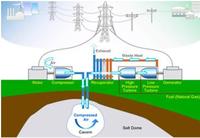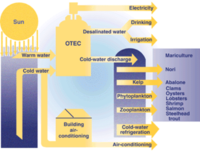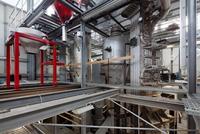-
Algae could become an important source of fuel in U.S.

A new analysis shows that the U.S. land and water resources could likely support the growth of enough algae to produce up to twenty-five billion gallons of algae-based fuel a year in the United States, one-twelfth of the country’s yearly needs.
-
-
Compressing air for renewable energy storage

Enough Northwest wind energy to power about 85,000 homes each month could be stored in porous rocks deep underground for later use, according to a new, comprehensive study. Researchers identified two unique methods for this energy storage approach and two eastern Washington locations to put them into practice.
-
-
Increasing supplies of North American oil changing global markets
The supply shock created by a surge in North American oil production will be as transformative to the market over the next five years as was the rise of Chinese demand over the last fifteen, a new report says. The shift will not only cause oil companies to overhaul their global investment strategies, but also reshape the way oil is transported, stored, and refined.
-
-
The cost for universal access to energy
Universal access to modern energy could be achieved with an investment of between $65 and $86 billion a year up until 2030, new research has shown. The proposed investments are higher than previous estimates but equate to just 3-4 percent of current investments in the global energy system.
-
-
EPA slams State Department’s Keystone XL pipeline review
The Environmental Protection Agency (EPA) on Monday criticized the State Department’s environmental impact review of the Keystone XL pipeline, saying there was not enough evidence to back up key conclusions in the review on emissions, safety, and alternative routes. The EPA’s comments could have a negative effect on the approval of the project, but if the project is approved, the comments could serve as supporting evidence in any ligation against the pipeline.
-
-
Ocean thermal energy conversion power plant to be built off southern China’s coast

Lockheed Martin has announced that it is working with Chinese company Reignwood Group to develop an Ocean Thermal Energy Conversion (OTEC) pilot power plant off the coast of southern China. The prototype plant will be the first project in the multi-billion dollar clean energy agreement between the two companies. OTEC takes the natural temperature difference found in the ocean in tropical regions and uses it to create power. This technology is well-suited to island and coastal communities.
-
-
DOE seizes $21 million from Fisker after company fails to make monthly payment on loan
The administration seized $21 million from auto company Fisker Automotive, less than a month after the automaker laid off three quarters of its employees due to financial and production problems. Fisker, based in Anaheim, California, was awarded a $192 million loan as part of a program started by the Obama administration to boost electric cars and other alternative-fuel vehicles.
-
-
Scientists discover new materials to capture methane
Scientists have discovered new materials to capture methane, the second highest concentration greenhouse gas emitted into the atmosphere. Unlike carbon dioxide, the largest emitted greenhouse gas, which can be captured both physically and chemically in a variety of solvents and porous solids, methane is completely non-polar and interacts very weakly with most materials.
-
-
First U.S. commercial enhanced geothermal system connected to the grid

Enhanced geothermal system (EGS) projects capture power from intensely hot rocks, buried thousands of feet below the surface, which lack the permeability or fluid saturation found in naturally occurring geothermal systems. The Energy Department the other day announced the U.S. first commercial EGS project which supplies electricity to the grid.
-
-
Renewable energy could economically replace fossil-based energy in Australia
A carbon price of between AU$50 and AU$100 per ton of carbon dioxide would make coal-fired and gas-fired power in Australia less economical than renewable electricity. A new study says that all fossil-fuelled power stations in Australia’s National Electricity Market could be phased out and replaced economically and reliably with commercially available renewable energy technologies by increasing the carbon price to this “medium” level.
-
-
U.S. nuclear industry faces a wave of nuclear power station retirements
A wave of U.S. nuclear power station retirements is on the horizon. The typical design life of a nuclear power plant is 40 years. There are 104 nuclear power plants in the United States, and their average age is 34 years — only a few years short of, and fast approaching, their design life. Almost 30 U.S. commercial and research reactors already have started decommissioning. A $400 million is regarded as the bargain basement price tag for cleaning up a single reactor.
-
-
Using waste heat to capture CO2 before it goes up in smoke

Power plants fired by coal and natural gas account for about half of the CO2 that humans add to the atmosphere each year; these power plants are prime candidates for new technology that captures CO2 before it goes up in smoke. Researchers seek to optimize CO2 removal from power plant emissions by employing waste heat. This is just one example of looking to improve upon a tried-and-true technology for CO2 capture. That technology — a two-phase chemical process — has been used for decades to remove naturally occurring CO2 from natural gas.
-
-
U.S. to cut mineral payment to states by $110 million between now and August
The U.S. Department of Interior will cut its federal mineral payments to thirty-five states by $110 million due to the federal budget cuts. Different states will lose different amounts of money: Wyoming tops the list with $53 million in lost federal mineral payments over the next five months, while North Carolina is bringing up the rear, with the federal government cutting its mineral payments to the state by $7 (seven dollars) between now and August.
-
-
Coming soon: fuel made directly from CO2 in the atmosphere
Excess carbon dioxide in the Earth’s atmosphere created by burning of fossil fuels is a major driving force of global climate change. Now, researchers have found a way to transform the carbon dioxide trapped in the atmosphere into useful industrial products – including biofuels made directly from the carbon dioxide in the air.
-
-
Fluctuating wind power as a solution rather than a problem
Incorporating wind power into existing power grids is challenging because fluctuating wind speed and direction means turbines generate power inconsistently. Coupled with customers’ varying power demand, many wind-farm managers end up wasting power-generation capacity and limiting the service life of turbines through active control in order to avoid any possible damage to the power grid from spikes in supply.
-
More headlines
The long view
Trump Is Fast-Tracking New Coal Mines — Even When They Don’t Make Economic Sense
In Appalachian Tennessee, mines shut down and couldn’t pay their debts. Now a new one is opening under the guise of an “energy emergency.”
Smaller Nuclear Reactors Spark Renewed Interest in a Once-Shunned Energy Source
In the past two years, half the states have taken action to promote nuclear power, from creating nuclear task forces to integrating nuclear into long-term energy plans.
